Wednesday Night Racing Debut
Published on April 29th, 2021
Racing rules expert Dave Perry isn’t a huge fan of beer can racing as he contends the sport succeeds when competitors respect and follow the rules, and for midweek racing, the casual atmosphere tends to loosen the grip on rules diligence.
He isn’t wrong, so to enjoy this popular racing format may require going back to what instructors counsel while teaching automobile driving to distracted teenagers: practice defensive driving. Following strategies that minimize risk and help avoid accidents on these nights may be necessary.
But another reason for defensive driving, at least for the start of the season, is that amid the boats and wind and sails is a whole lot of rust. Unless you can somehow stay active in the winter, spring sailing is not when our skills are sharpest.
In this report by Tim Zimmermann, he shares the rust and reality of his Wednesday night racing debut at Annapolis Yacht Club:
After last week’s racing was cancelled due to a gale warning, it was nice to see a solid 10-knot forecast this week. And, at the start, we had…10 knots. Perfect.
The start was the expected chaos of AYC Wednesday Night Racing, with dozens of boats milling around the outer starting area, many in the starting box when it wasn’t their start. We were racing Moondust (Beneteau First 36.7) in ORC 2, and it has been a long time since I have been on such a busy starting line in anything bigger than a Laser.
It almost ended in the one outcome I would really, really, like to avoid: a major collision.
It was my fault. On a Laser, it is easy to see everything around you, and of course you are highly maneuverable. But on Moondust, the genoa blocks a lot of your vision and you are less maneuverable. You have to rely on your bowperson to guide you, and that is an adjustment for me (which I almost made too late).
The course setup heavily favored starting at the committee boat end. With a few minutes to our start I was working my way on port toward that end of the line. My plan was to tack back onto starboard at 30-60 seconds and try and find a lane.
“Head down, head down,” Lisa suddenly shouted from the bow. Lisa is very, very good at what she does. I should have responded instantly. Instead, used to sailing a dinghy or shorthanded and processing everything myself, I tried to see peek around the genoa to see what she saw.
“Down, down,” she shouted again, and I started to turn the wheel. “Up, up,” came an even more urgent cry from the bow. The starboard tack boat was apparently now bearing off hard to try and avoid the idiot port-tacker.
I spun the wheel the other way, and saw the other boat emerge from behind the genoa, just a few feet below the leeward rail, passing at a combined speed of probably 10 knots. We were so close that if either of us had turned hard our sterns would have smacked into one another. Hard.
I braced for the horrid sound of crunching fiberglass. Somehow, amazingly, we got by without contact.
It was quite an intro, and quite a wake-up (note to self: always do what Lisa says…instantly). And, later, I had a pit in my stomach about what might have happened. But with the start fast approaching, there was no time to relive it. We tacked onto starboard with about 30 seconds, slowed down to stay on time and try and avoid being shut out at the committee boat by Aunt Jean, a J/35.
Aunt Jean and another boat had judged their angle well, and we were forced to let them cross the line ahead of us before starting. On the upside, we were able to flip onto port shortly after the start, to find clear air and get the boat moving.
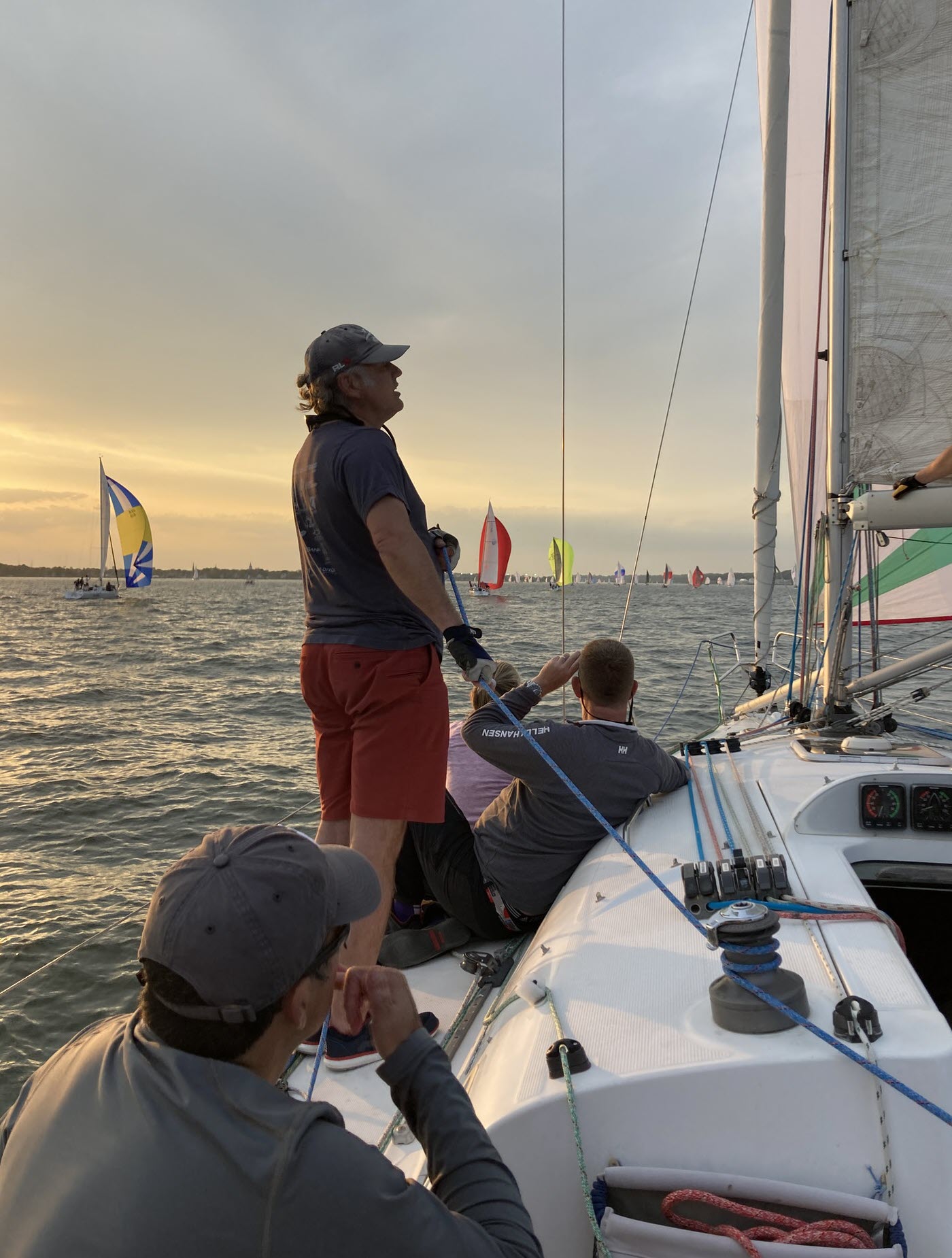 The leg to the first turning mark was heavily starboard tack favored. But there was enough port that we were able to clear our air one more time on port, and find a good starboard lane toward the mark. We left the mark to port and started reaching toward the next mark.
The leg to the first turning mark was heavily starboard tack favored. But there was enough port that we were able to clear our air one more time on port, and find a good starboard lane toward the mark. We left the mark to port and started reaching toward the next mark.
The most notable thing for me was the huge difference in the feel of the B36.7 with weight on the rail (we were 8 total). It was obvious this would be true. But I hadn’t felt it before. And it felt really good. This was the first time our full crew had sailed together. And the first time I had raced the boat with full crew. So we tweaked the trim and worked on trying to go fast.
The next leg was upwind to a mark out in the Bay. With the last of the flood still coming in, most of the fleet took a long port tack back into the Severn. It was really nice sailing, and all was well with the world. Until we looked out toward the mark and saw a total park up.
The Chesapeake can be a very weird place to sail, especially when the wind does funny things as the sun goes down. And in this instance, we could be in a light, steady breeze, a half mile away and sailing straight at the mark, and boats around the mark were at a standstill.
It is impossible not to start thinking and hoping that you might carry the breeze with you, close on everyone stuck at the mark, and smoothly tack at the mark and glide past, for an epic gain. But you would be naive to even entertain this possibility.
Of course, the wind stopped blowing as we closed the mark, and we stopped too. There were moments when I thought we might get around in good shape. But boats were pointed in every direction. The zephyrs at the masthead was completely different than the zephyrs on deck. And we were not one of the lucky boats.
It probably took us 20 minutes to pass the mark, and advance far enough past it for the breeze to turn back on and steady enough for us to hoist the asymmetrical and head back up the Severn. And that was long enough to do fatal damage to our prospects.
It is the sort of setback that requires perspective. And we were now gliding toward Annapolis, into a setting sun, with spinnakers all around. It is pretty hard not to feel happy in that moment.
We played with taking the asymmetrical from the bow to the spinnaker pole (good idea because we could sail deeper), and back to the bow. Which made me and Rich happy, and taught us a little more about how to make the best use of this still unfamiliar sail. It was a very fine evening.
The other important element of perspective racing on these waters is: what the Chesapeake takes away, it often gives back. As we got within a mile of the last turning mark, a red nun to be left to port, leading to a final leg up Spa Creek to the finish, we could see…another massive park up.
Lots of boats had worked their way toward the northern side of the Severn, and they were slowing and stopping. We were in the middle of the river and moving, on port gybe, so we carried on, gybed onto the starboard layline, and looked (once again) as if we had a chance of leapfrogging past a big clump of boats, gybing smartly at the mark and sailing away to the finish.
I guess I am a sucker because, of course, the wind gods find amusement in tormenting idiot optimists.
Once again, the breeze started to die as we closed within 100 meters of the mark, and what was left was roiled by dozens of boats all trying to sneak their way around. We rounded, aimed the bow toward the finish…and sat there. And sat a little while longer. Again, boats pointed every which way on different tacks, and no one really going anywhere.
The story of this race was that you had to round that last mark out in the Bay cleanly and quickly enough to get to this mark and the finish before the breeze shut off. And we hadn’t.
At .03 knots of boatspeed we were not going to finish before the time limit expired. It was just past 8 pm. Our navigation lights were on. The AYC bar awaited the AYC contingent of the crew. The rest of us still had to motor the 45 minutes back to Whitehall. I started the motor and we dropped the sails.
Others started motoring toward the finish too. Just four of the 15 boats in our ORC 2 division finished in time (so now we know who to pay attention to). We passed some of them creeping toward the finish as we dropped off crew. That’s how it goes sometimes.
Despite the disappointing ending, there were plenty of good moments. And it is always fun to start to get to know a crew and have confidence that the boat will go faster and faster with every race we do. The quiet motor back to Whitehall, with a beer in hand, wasn’t a bad way to finish a fine evening on the water. I’m eager for more.
Here’s how T2PTV saw it:


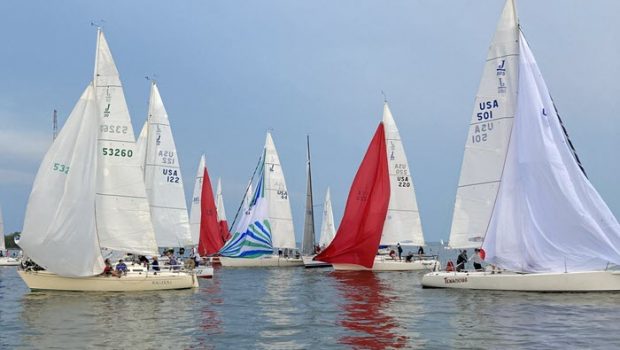



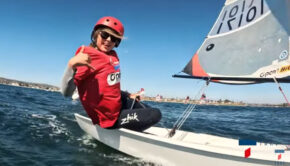
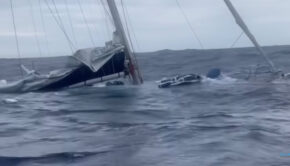
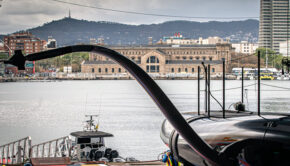
 We’ll keep your information safe.
We’ll keep your information safe.